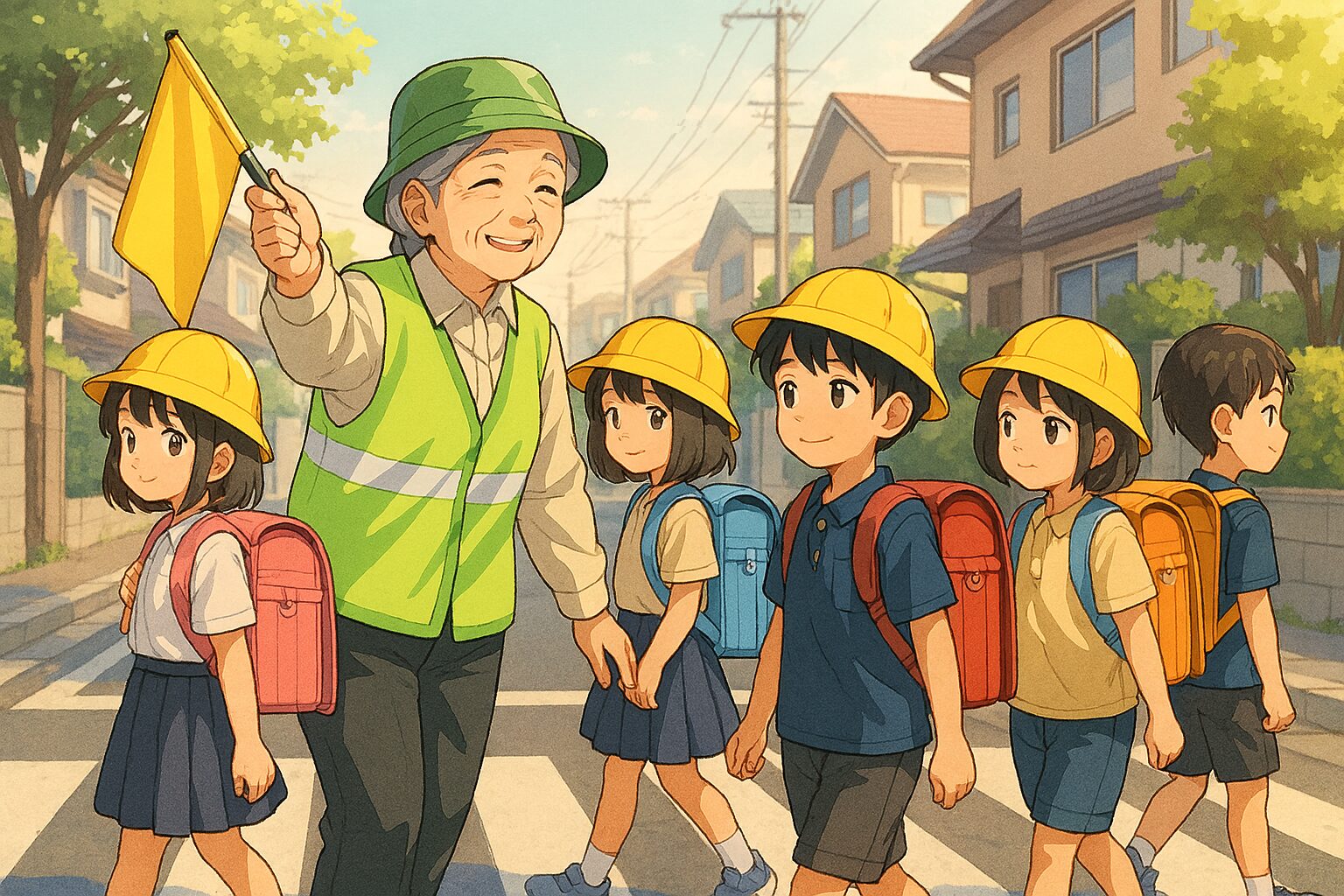November 19th: What is Green Auntie Day?
November 19th commemorates the establishment of school crossing guards in Japan, affectionately known as “Green Aunties.” The system first started in Tokyo on this day in 1959 (Showa 34).
Historical Background: The Era of the “Traffic War”
Why was this system necessary? Let’s turn the clock back to the 1950s. Japan was in the midst of rapid economic growth. While motorization (the widespread adoption of cars) was advancing quickly, infrastructure like traffic lights and sidewalks couldn’t keep up.
As a result, traffic accidents skyrocketed, and many children fell victim. The situation was so dire, with fatalities exceeding those of the First Sino-Japanese War, that it was called the “Traffic War.” Driven by the desperate wish of parents to protect their beloved children and government measures, women holding yellow flags and wearing green uniforms began to stand at intersections.
Why “Green” and Why “Auntie”?
Their official title is “School Safety Attendant” (Gakudo Yogo-in). However, they became widely and affectionately known as “Green Aunties.”
- Why Green: Green is a symbol of peace and safety, providing psychological calmness. It was also intended to increase visibility on the stark roads of that time.
- Why Auntie: When the system started, the role was primarily filled by local housewives or older women employed as a relief measure for widows. They acted as “surrogate mothers” in the community, constantly speaking to and watching over the children.
Deciphering Japanese Culture from the Green Auntie: The Aesthetics of Safety and Care
This anniversary is not just about traffic safety. It symbolizes the “culture of watching over” (Mimamori) that lies deep within Japanese society.
1. The Magic of “Itterasshai” (Have a Safe Trip)
On Japanese mornings, the Green Auntie doesn’t just stop cars. She says “Ohayo!” (Good morning) and “Itterasshai!” (Go safely) to each child. This is an expression of the traditional Japanese community mindset that “it takes a village to raise a child.” It is not mechanical traffic control; there is a connection of “heart.” The Japanese value of Jo (emotion/compassion) is present there.
2. Volunteer Spirit and Changing Roles
More than 60 years have passed since the system began. Today, it is mainly supported by volunteers from PTAs and local senior citizens’ clubs, rather than just employed staff. Also, as more men participate, “Green Uncles” are no longer rare. However, the dedication to standing at the same spot every day, rain or shine, remains unchanged. This strongly reflects Japanese diligence and the spirit of valuing public welfare.
3. Affinity with Randoseru Culture
Who are the Green Aunties protecting? Elementary school students carrying heavy “Randoseru” backpacks. Japan’s style of young children walking to school alone is rare globally (sometimes referred to as “Old enough to run an errand,” but actually, society watches over them). This unique commuting system exists precisely because of the watchful eyes of adults in the community, like the Green Aunties.
Modern Challenges and the Future
In Japan’s aging society, finding people to stand at intersections is becoming a serious issue. However, the spirit is not just being replaced by AI or surveillance cameras but is being inherited in new forms like “Children’s 110 Homes” and community patrols. November 19th is a day to reaffirm how much we were protected by the “goodwill of strangers” as we grew up.
To Our Readers
How do children commute to school in your country? Do you have a culture like Japan’s where local elderly people or volunteers stand at intersections every morning to exchange greetings? Or are school buses the norm?
If you visit Japan and see someone waving a flag in a green vest on a morning street corner, please whisper “Thank you” in your heart. They are the unsung heroes protecting Japan’s safety.
Would you be willing to stand at an intersection every morning for the children in your community?
References & Related Info
- Kanagawa Prefectural Police (Traffic Safety) – Examples of traffic safety education by Japanese police.
- What’s Today’s Special Day Series – Click here for more Japanese anniversaries.
日本の朝、通学路で見かける鮮やかな緑色。それは単なる制服ではなく、日本の「安全神話」と「地域コミュニティ」を支えてきた象徴的な存在です。11月19日は、日本で「緑のおばさんの日」として知られています。なぜ「緑」なのか、なぜ「おばさん」なのか。この記念日を深掘りすることで、日本の戦後史と、子供を守るという独自の精神性が見えてきます。
11月19日:緑のおばさんの日とは何か?
11月19日は、日本における通学路の安全を守る学童擁護員、通称「緑のおばさん」が誕生したことを記念する日です。1959年(昭和34年)のこの日、東京都で初めてこの制度がスタートしました。
歴史的背景:交通戦争と呼ばれた時代
なぜこの制度が必要だったのでしょうか。時計の針を1950年代に戻しましょう。当時の日本は高度経済成長期の真っ只中。急速なモータリゼーション(自動車の大衆化)が進む一方で、信号機や歩道の整備は追いついていませんでした。
その結果、交通事故が激増し、多くの子供たちが犠牲となりました。この悲惨な状況は、日清戦争の死者数をも上回る勢いだったことから「交通戦争(Traffic War)」と呼ばれました。愛する子供を交通事故から守りたい。その切実な親たちの願いと行政の対策が結実し、緑色の制服と黄色い旗を持った女性たちが交差点に立つようになったのです。
なぜ「緑」で「おばさん」なのか?
彼女たちの正式名称は「学童擁護員」です。しかし、親しみを込めて「緑のおばさん(Green Auntie)」と呼ばれ定着しました。
- 緑色の理由:平和と安全の象徴であり、心理的に落ち着きを与える色だからです。また、当時の殺風景な道路において、視認性を高める狙いもありました。
- おばさんの理由:制度開始当初、この役割を担ったのは主に地域の主婦や、未亡人救済事業として雇用された年配の女性たちでした。彼女たちは地域コミュニティにおける「母親代わり」として、子供たちに声をかけ続けました。
緑のおばさんから読み解く日本文化:安全と「お節介」の美学
この記念日は単なる交通安全の日ではありません。日本社会の深層にある「見守り文化」を象徴しています。
1. 「行ってらっしゃい」の魔法
日本の朝、緑のおばさんは単に車を止めるだけではありません。子供たち一人ひとりに「おはよう!」「行ってらっしゃい!」と声をかけます。これは、地域全体で子供を育てるという日本の伝統的なコミュニティ意識の表れです。無機質な交通整理ではなく、そこに「心」を通わせる。日本人が大切にする「情(Jo – emotion/compassion)」がそこにあります。
2. ボランティア精神と役割の変化
制度開始から60年以上が経過し、現在は雇用された職員だけでなく、PTAや地域の老人クラブによるボランティアが主流になっています。また、男性も増えたため「緑のおじさん」も珍しくありません。しかし、雨の日も風の日も、毎日同じ場所に立ち続ける献身性は変わりません。これは日本人の勤勉さと、公共の福祉を重んじる精神性を強く反映しています。
3. ランドセル文化との親和性
緑のおばさんが守る対象は、重い「ランドセル」を背負った小学生たちです。世界でも珍しい、子供だけで徒歩通学をする日本のスタイル(Pigs walk aloneと言われることもありますが、実際は社会全体が見守っています)。このユニークな通学システムが成立しているのは、緑のおばさんをはじめとする、地域の大人の監視の目があるからこそなのです。
現代における課題と未来
高齢化が進む日本において、誰が交差点に立つのかは深刻な問題になりつつあります。しかし、その精神はAIや見守りカメラに置き換わるだけではなく、形を変えて「子供110番の家」や地域パトロールへと受け継がれています。11月19日は、私たちがどれだけ多くの「見知らぬ善意」によって守られて大人になったのかを再確認する日なのです。
読者の皆様へ
あなたの国では、子供たちはどのように通学していますか? 日本のように、地域のお年寄りやボランティアが毎朝交差点に立って挨拶を交わす文化はありますか? それとも、スクールバスが一般的でしょうか?
もしあなたが日本を訪れて、朝の街角で緑色のベストを着て旗を振っている人を見かけたら、心の中で「ありがとう」と呟いてみてください。彼らは日本の安全を守る、名もなきヒーローなのです。
あなたなら、自分の地域の子供たちのために、毎朝交差点に立つことができますか?
参考リンク・関連情報
- 神奈川県警察(交通安全教育の例) – 日本の警察による交通安全の取り組み
- What’s Today’s Special Day Series – その他の日本の記念日についてはこちら



コメント